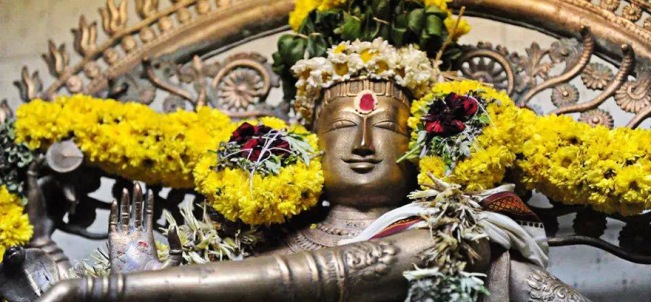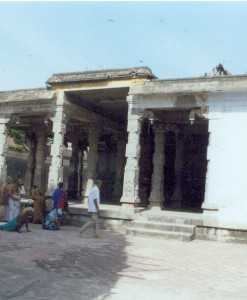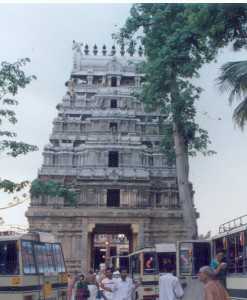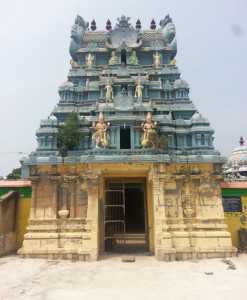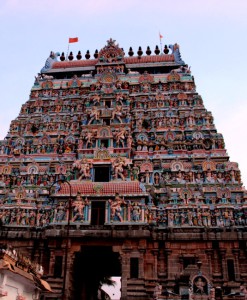No products in the cart.
Chidambaram Nataraja Temple, Chidambaram or Chidambaram temple is a Hindu temple dedicated to Lord Shiva located in the town ofChidambaram, East-Central Tamil Nadu, South India. The temple is known as the foremost of all temples (Kovil) to Saivites and has influenced worship, architecture, sculpture and performance art for over two millennium. The Sangam classics list chief architect Viduvelvidugu Perumtaccan as directing an early renovation of the shrine.
A major shrine of Lord Shiva worship since the classical period, there have been several renovations and offerings to Chidambaram by the Pallava, Chola, Pandya, Vijayanagara and Chera royals in the ancient and pre-medieval periods. Chidambaram Nataraja Temple as it stands now is mainly of the 12th and 13th centuries, with later additions in similar style.[1] Its bronze statues and stone sculptures depicting various deities and the famous Thillai trees (Excoecaria agallocha) of the surrounding forest reflect the highpoints of early Chola and Pallava art while its famed gold plated gopuram towers are medieval structural additions by the royals Aditya I, Parantaka Chola I,Kopperunchinga I, Krishnadevaraya and Jatavarman Sundara Pandyan. King Kocengannan Chola was born following prayers his parents offered at the temple and later in his life he refined its structure.The shrine gave the town its name.
Chidambaram Nataraja Temple, Tamil Nadu
Chidambaram Nataraja Temple is the only great temple complex to date mainly from the later Chola period, and contains the earliest examples of a number of features that are found in many later temples, including “the earliest known Devī or Amman shrine, vŗtta (dance) maṇḍapa, Sūrya shrine with chariot wheels, hundred-and-thousand pillared maṇḍapas, even the first giant Śiva Gangā tank”.[17]
A classical Shiva temple as per Agama rules will have five prakarams (closed precincts of a temple) or circuits each separated by walls one within the other. The outer prakaramwill be open to the sky except the innermost one. The innermost one will house the main deity as well as other deities. There will be a massive wooden or stone flag post exactly in line with the main deity. The innermost prakaram houses the sanctum sanctorum (karuvarai in Tamil).
Constructed to signify where Tamil Shaivites identify the centre loci of the universe to be, the shrine, dedicated to Lord Shiva, has witnessed several significant events in thehistory of Tamil Nadu. A powerful legacy of Dravidian art, its structures and sculptures have attracted pilgrims to Chidambaram for over two millennium. The birthplace of Natarajawhen Shaivite worship was highly popular during the Sangam period, Chidambaram had gained a reputation for holiness across the continent by the third century CE and the admiration of the Tamilakkam royals of the early Cholas, Chera dynasty and the early Pandyan Kingdom. Built by the early Cholas to one of their family deities – Nataraja-Koothan – it served as the king and queen’s state temple and seat of their monarchs’ coronations. The Chola royals underlined their non-partisan approach to religious iconography and faith by also patronizing the Srirangam Ranganathaswamy temple dedicated to Vishnu – their other Kuladheivam or “abode of family deity”. Chola King Kocengannan who reigned in the first half of the 2nd century CE was born after his parents King Subhadevan and Kamaladevi worshipped in the Thillai Golden Hall (Pon Ambalam). He expanded the shrine in his later life and added to unfinished decorations. Saints Patañjali Tirumular and Vyaghrapada famously worshipped Nataraja at the shrine.[52][53][54] The travelling Pallava-Chola king Simhavarman (II or III) who reigned in the 5th-6th century CE was cured of leprosy by bathing in the Shivagangai tank and in gratitude made extensive repairs and additions to the temple. He changed his name to Hiranyavarman or “golden bodied.”
The Puranas, Sangam literature and the Tirumurai canon join several epigraphs and murals in highlighting the brilliance of the temple site and the devotion of Patañjali, Vyaghrapada-Pulikaalmunivar and patanjali to Nataraja at Thillai. The sthala puranam as well as umapathi sivacharya’s koyil puranam give an account of how an ancient chola prince of kritayugam or first of epochal ages. Worshipped The Lord’s feet at Chidambaram and being blessed with a vision of His was further helped by saint Vyaghrapada to consecrate a place of worship therewith. The temple murals and some cholan and pandyan literature refer to this sthala puranam. The chidambaram mahatyam as well as koyil puranam by the same author discuss as to how this prince who was presented with dhataki or atti garland and tiger flag in which Lord Indra would take abode to make him ever victorious was blessed with vision of lord and further attained mukti at this spot. This is very credible because all ancient literature and documents report that tiger flag and atti or dhataki (grislea tomentosa) garland as being emblematic with cholas. Some sangam period works also passingly refer to the krita age king’s war with demons and his victory against them. The king also went by name Vyaghraketu after being gifted with the tiger flag.
Later during the 4th or 5th century .C.E, a pallava king called Simha Varman who was also a nayanmar saint by name Aiyatikal Kaadavarkon made some compositions and bathed in the tank and attained mukthi at tiru-perum-ppatra-puliyur or chidambaram. Aragalur Udaya Iraratevan Ponparappinan had refurbished most of the parts and rebuilt some parts of the temple around 1213 AD.
At periodical intervals (12 years in general), major repairs and renovation works are carried out, new facilities added and consecrated. Most old temples have also ‘grown’ over periods of time with additional facilities, more outer corridors and new gopurams (pagodas) were added by the rulers who patronized the temple. While this process has helped to keep the temples ‘alive’ as places of worship, from a purely archeological or historical perspective these renovations have unintentionally lead to destruction of the original works – which were not in sync with the latter and usually grander temple plans.
To this general trend, Chidambaram temple is no exception. The origins and developments of the temple are hence largely deduced from allied references in works of literature and poetry, the verbal information passed over generations by the Dikshithar community and from what little, of inscriptions and manuscripts that are available today.
The temple site is very ancient one is known to have been crafted time and again by the ancient craftsmen guild known as perumtaccans. The reference to the same is available in sangam literature as well as other documents. The tevaram trio in particular have held this site to be of great sanctity with some like tirugnanasambandar and sundarar out of devotion being reluctant to set their foot in the place “because it would be an insult to the lord to put one’s foot on his abode”. The sangam works refer to the temple being favoured by all the three ancient crowns of south, the Neriyan (cholas), chezhiyan (pandyas) and uthiyan (cheras), even if the temple was in what was traditionally chola country.
Chidambaram Nataraja Temple is open from 6.00 a.m. to 12.30 p.m. and from 4.30 p.m. to 10.00 p.m.
A whole year for men is said to be a single day for the gods. Just as six poojas are performed in a day at the sanctum sanctorum, six anointing ceremonies are performed for the principal deity – Nataraja in a year. They are the Marghazhi Thiruvaadhirai (in December – January ) indicating the first puja, the fourteenth day after the new moon (chaturdasi) of the month of Masi (February – March) indicating the second pooja, the Chittirai Thiruvonam (in April- May), indicating the third pooja or uchikalam, the Uthiram of Aani (June–July) also called the Aani Thirumanjanam indicating the evening or the fourth puja, the chaturdasi of Aavani (August – September) indicating the fifth puja and the chaturdasi of the month of Puratasi (October – November) indicating the sixth pooja or Arthajama. Of these the Marghazhi Thiruvaadhirai (in December – January) and the Aani Thirumanjanam (in June – July ) are the most important. These are conducted as the key festivals with the main deity being brought outside the sanctum sanctorum in a procession that included a temple car procession followed by a long anointing ceremony.Several hundreds of thousands of people flock the temple to see the anointing ceremony and the ritualistic dance of Shiva when he is taken back to the sanctum sanctorum. Lord Shiva, in his incarnation of Nataraja, is believed to have born on full moon day in the constellation of Ardra, the sixth lunar mansion. Lord Shiva is bathed only 6 times a year, and on the previous night of Ardra, the bath rituals are performed on a grand scale.Pots full of milk, pomegranate juices, coconut water, ghee, oil, sandal paste, curds, holy ashes, and other liquids and solids, considered as sacred offering to the deity are used for the sacred ablution.
A unique feature of this temple is the bejeweled image of Lord Nataraja as the main deity. It depicts Lord Shiva as the master of Koothu–Bharata Natyam and is one of the few temples where Lord Shiva is represented by an anthropomorphic murthi rather than the classic, anionic Lingam.
At Chidambaram, the dancer dominates, not the linga as in other Shiva shrines. The Chitsabha houses a small sphatika(crystal) linga (Chandramoulisvara), believed to be a piece that fell from the crescent adorning Lord Shiva’s head and installed by Adi Shankara. The linga is associated with the intangible fifth element, akasha (ether or space), the eternal infinite expanse where the dance of Lord Shiva takes place daily puja is offered to the linga and also to a small gem-carved figure of Ratnasabhapati.
Chidambaram offers a combination of the three apects of Shaiva worship – of the form Lord(Nataraja), of the form and the formlessness (linga) and of the formless omnipresence. The last is suggested by a “Chidambara rahasya”, a chakra inscribed on a wall and blackened by applying “punugu” (civet) and over which hangs a string of golden villa (bael) leaves. This can be viewed through the square chinks when the priest draws aside the dark “curtain of ignorance”.
BY FLIGHT
Chidambaram does not have an airport. Nearest airport is Pondicherry Airport.68km from airport to temple.
BY TRAIN
Chidambaram railway station is nearest station.
BY BUS
There are regular buses from other major cities of the country to Chidambaram.


